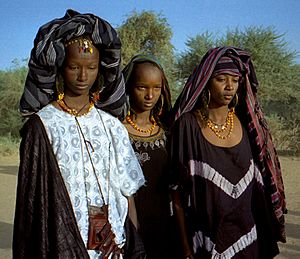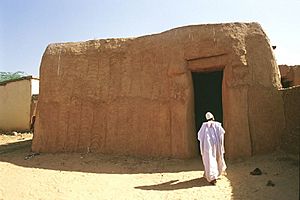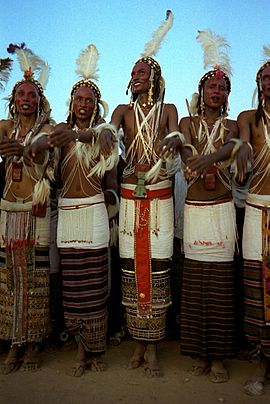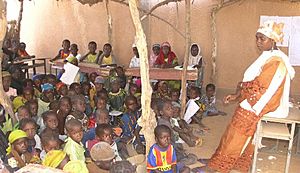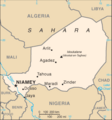Niger facts for kids
Quick facts for kids
Republic of the Niger
République du Niger (French)
|
|
|---|---|
|
|
|
|
Motto:
|
|
|
Anthem: L'Honneur de la Patrie (French)
"The Honour of the Fatherland" |
|

Location of Niger (dark green)
|
|
| Capital and largest city
|
Niamey 13°32′N 2°05′E / 13.533°N 2.083°E |
| Official languages | French |
| National languages |
|
| Ethnic groups
(2021)
|
|
| Religion
(2012)
|
|
| Demonym(s) | Nigerien |
| Government | Unitary semi-presidential republic under a military junta |
| National Council for the Safeguard of the Homeland | |
| Vacant | |
|
• President of the National Assembly
|
Vacant |
| Legislature | National Assembly |
| Independence
from France
|
|
|
• Republic proclaimed
|
18 December 1958 |
|
• Declared
|
3 August 1960 |
| Area | |
|
• Total
|
1,267,000 km2 (489,000 sq mi) (21st) |
|
• Water (%)
|
0.02 |
| Population | |
|
• 2023 estimate
|
25,396,840 (56th) |
|
• Density
|
12.1/km2 (31.3/sq mi) |
| GDP (PPP) | 2022 estimate |
|
• Total
|
|
|
• Per capita
|
|
| GDP (nominal) | 2022 estimate |
|
• Total
|
|
|
• Per capita
|
|
| Gini (2014) | ▲ 34.0 medium |
| HDI (2021) | low · 189th |
| Currency | West African CFA franc (XOF) |
| Time zone | UTC+1 (WAT) |
| Driving side | right |
| Calling code | +227 |
| ISO 3166 code | NE |
| Internet TLD | .ne |
Niger is a country in western Africa. The capital is Niamey, and the official language is French. It is surrounded by Algeria and Libya to the north, Chad to the east, Nigeria and Benin to the south, and Burkina Faso and Mali to the west. Niger is landlocked, meaning it has no coastline. Niger gets its name from the Niger River.
The Mali Empire and the Songhai Empire both had land in what is now Niger. Later France controlled the land that is now Niger. Niger has a population, or the number of people living in an area, of 15,306,252 and an area of 1,267,000 square kilometres. Much of Niger is desert.
Following the adoption of a constitution in 2010 and presidential elections a year later, Mahamadou Issoufou was elected as the first president of the Seventh Republic; he was then re-elected in 2016. The constitution restored the semi-presidential system which had been abolished a year earlier. An attempted coup against him in 2011 was thwarted and its ringleaders arrested. Issoufou's time in office was marked by threats to the country's security, stemming from the fallout from the Libyan Civil War and Northern Mali conflict, an insurgency in western Niger by al-Qaeda and Islamic State, the spillover of Nigeria's Boko Haram insurgency into south-eastern Niger, and the use of Niger as a transit country for migrants (often organised by people-smuggling gangs). French and American forces are assisting Niger in countering these threats.
On 27 December 2020, Nigeriens went to the polls after Issoufou announced he would step down, paving the way to a peaceful transition of power. No candidate won an absolute majority in the vote: Mohamed Bazoum came closest with 39.33%. As per the constitution, a run-off election was held on 20 February 2021, with Bazoum taking 55.75% of the vote and opposition candidate (and former president) Mahamane Ousmane taking 44.25%, according to the electoral commission.
On 31 March 2021, Niger's security forces thwarted an attempted coup by a military unit in the capital, Niamey. Gunfire was heard in the presidential palace. The attack took place two days before newly elected president Mohamed Bazoum was due to be sworn into office. The Presidential Guard arrested some people during the incident. On 2 April 2021, Bazoum was sworn in as the President of Niger.
Late on 26 July 2023, a coup by the military overthrew Bazoum, putting an end to the Seventh Republic. On 28 July, General Abdourahamane Tchiani proclaimed himself as the de facto president of the country.
Contents
Geography
Niger is on the border between the Sahara and Sub-Saharan regions. Niger's area is 1,267,000 square kilometres (489,191 sq mi) of which 300 square kilometres (116 sq mi) is water. It is the world's twenty-second largest country. Niger borders seven countries. The longest border is with Nigeria to the south.
The lowest point is the Niger River, with an elevation of 200 metres (656 ft). The highest point is Mont Idoukal-n-Taghès in the Aïr Mountains at 2,022 m (6,634 ft).
Largest cities and towns
|
Largest cities or towns in Niger
According to the 2012 Census |
||
|---|---|---|
| Rank | Name | Pop. |
| 1 | Niamey | 978,029 |
| 2 | Maradi | 267,249 |
| 3 | Zinder | 235,605 |
| 4 | Tahoua | 117,826 |
| 5 | Agadez | 110,497 |
| 6 | Arlit | 78,651 |
| 7 | Birni-N'Konni | 63,169 |
| 8 | Dosso | 58,671 |
| 9 | Gaya | 45,465 |
| 10 | Tessaoua | 43,409 |
Climate
Niger's subtropical climate is mainly very hot and dry. Much of it is covered by desert. In the extreme south there is a tropical climate on the edges of the Niger River basin. The land is mostly desert plains and sand dunes. There is flat to rolling savanna in the south and hills in the north.
Wildlife
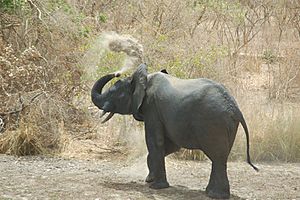
The north of Niger is covered by large deserts and semi deserts. The typical mammal fauna consists of Addax antelopes, Scimitar-horned oryx, gazelles and in mountains Barbary sheep. One of the largest reserves of the world, the Aïr and Ténéré National Nature Reserve, was founded in the northern parts of the Niger to protect these rare species.
The southern parts of Niger are naturally dominated savannahs. The W National Park, situated in the bordering area to Burkina Faso and Benin, belongs to one of the most important areas for wildlife in Western Africa, which is called the WAP (W–Arli–Pendjari) Complex. It has the most important population of the rare West African lion and one of the last populations of the Northwest African cheetah.
Other wildlife includes elephants, buffaloes, roan antelopes, kob antelopes and warthogs. The West African giraffe is currently not found in the W National Park, but further north in Niger, where it has its last relict population.
Economy
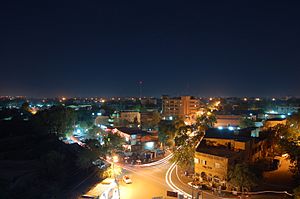
The economy of Niger centers on subsistence crops, livestock, and some of the world's largest uranium deposits. Drought cycles, desertification, a 2.9% population growth rate, and the drop in world demand for uranium have undercut the economy.
Society
Demographics
Expanding from a population of 1.7 million in 1960, Niger's population has rapidly increased with a current growth rate of 3.3% (7.1 children per mother).
This growth rate is one of the highest in the world and is a source of concern for the government and international agencies.
A 2005 study stated that over 800,000 people (nearly 8 per cent of the population) in Niger are enslaved.
Ethnic groups
Niger has a wide variety of ethnic groups as in most West African countries. The ethnic makeup of Niger is as follows: Hausa (53.0%), Zarma-Songhai (21.2%), Tuareg (10.4%), Fula (French: Peuls; Fula: Fulɓe) (9.9%), Kanuri Manga (4.4%), Tubu (0.4%), Arab (0.3%), Gourmantche (0.3%), other (0.2%).
Languages
French, inherited from the colonial period, is the official language. It is spoken mainly as a second language by people who have received a formal western education and serves as the administrative language. Niger has been a member of the Organisation Internationale de la Francophonie since 1970.
Niger has ten official national languages, namely Arabic, Buduma, Fulfulde, Gourmanchéma, Hausa, Kanuri, Zarma & Songhai, Tamasheq, Tassawaq, Tebu. Each is spoken as a first language primarily by the ethnic group with which it is associated.
Culture
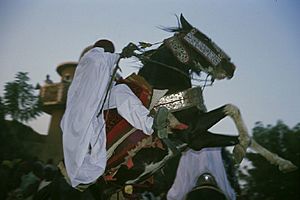
Nigerien culture is marked by variation, evidence of the cultural crossroads which French colonialism formed into a unified state from the beginning of the 20th century. What is now Niger was created from four distinct cultural areas in the pre-colonial era: the Zarma dominated Niger River valley in the southwest; the northern periphery of Hausaland, made mostly of those states which had resisted the Sokoto Caliphate, and ranged along the long southern border with Nigeria; the Lake Chad basin and Kaouar in the far east, populated by Kanuri farmers and Toubou pastoralists who had once been part of the Kanem-Bornu Empire; and the Tuareg nomads of the Aïr Mountains and Saharan desert in the vast north.
Each of these communities, along with smaller ethnic groups like the pastoral Wodaabe Fula, brought their own cultural traditions to the new state of Niger. While successive post-independence governments have tried to forge a shared national culture, this has been slow forming, in part because the major Nigerien communities have their own cultural histories, and in part because Nigerien ethnic groups such as the Hausa, Tuareg and Kanuri are but part of larger ethnic communities which cross borders introduced under colonialism.
Until the 1990s, government and politics was inordinately dominated by Niamey and the Zarma people of the surrounding region. At the same time the plurality of the population, in the Hausa borderlands between Birni-N'Konni and Maine-Soroa, have often looked culturally more to Hausaland in Nigeria than Niamey. Between 1996 and 2003, primary school attendance was around 30%, including 36% of males and only 25% of females. Additional education occurs through madrasas.
Festivals and cultural events
Guérewol festival
The Guérewol festival is a traditional Wodaabe cultural event that takes place in Abalak in Tahoua region or In'Gall in Agadez Region. It is an annual traditional courtship ritual practiced by the Wodaabe (Fula) people of Niger. During this ceremony, young men dressed in elaborate ornamentation and made up in traditional face painting gather in lines to dance and sing, vying for the attention of marriageable young women. The Guérewol festival is an internationally attraction and was featured in films and magazines as prominent as the National Geographic.
Cure Salée festival
"La Cure salée" (English: Salt Cure) is a yearly festival of Tuareg and Wodaabe nomads in In'Gall in Agadez Region traditionally to celebrate the end of the rainy season. For three days, the festival features a parade of Tuareg camel riders followed with camel and horse races, songs, dances, and storytelling.
Education
The literacy rate (the amount of the adult population who can read or write) of Niger is among the lowest in the world. In 2005 it was estimated to be only 28.7% (42.9% male and 15.1% female). Primary education in Niger is required for six years. The primary school enrollment and attendance rates are low, particularly for girls. Children are often made to work rather than attend school. This is particularly true during planting or harvest periods.
Related pages
Images for kids
-
President Hamani Diori and visiting German President Heinrich Lübke greet crowds on a state visit to Niamey, 1969. Diori's single party rule was characterised by "good" relations with the West and a preoccupation with foreign affairs.
-
A Tuareg rebel fighter in northern Niger during the Second Tuareg Rebellion, 2008
See also
 In Spanish: Níger para niños
In Spanish: Níger para niños




